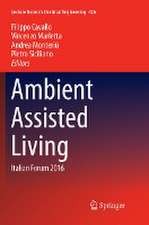Machine Learning in Biological Sciences: Updates and Future Prospects
Autor Shyamasree Ghosh, Rathi Dasguptaen Limba Engleză Hardback – 5 mai 2022
It is of relevance to post-graduate students and researchers interested in exploring the interdisciplinary areas of use of machine learning and deep learning in life sciences.
| Toate formatele și edițiile | Preț | Express |
|---|---|---|
| Paperback (1) | 1001.95 lei 6-8 săpt. | |
| Springer Nature Singapore – 6 mai 2023 | 1001.95 lei 6-8 săpt. | |
| Hardback (1) | 1008.12 lei 6-8 săpt. | |
| Springer Nature Singapore – 5 mai 2022 | 1008.12 lei 6-8 săpt. |
Preț: 1008.12 lei
Preț vechi: 1229.41 lei
-18% Nou
Puncte Express: 1512
Preț estimativ în valută:
192.93€ • 200.68$ • 159.27£
192.93€ • 200.68$ • 159.27£
Carte tipărită la comandă
Livrare economică 14-28 aprilie
Preluare comenzi: 021 569.72.76
Specificații
ISBN-13: 9789811688805
ISBN-10: 981168880X
Pagini: 336
Ilustrații: XXI, 336 p. 1 illus.
Dimensiuni: 155 x 235 mm
Greutate: 0.68 kg
Ediția:1st ed. 2022
Editura: Springer Nature Singapore
Colecția Springer
Locul publicării:Singapore, Singapore
ISBN-10: 981168880X
Pagini: 336
Ilustrații: XXI, 336 p. 1 illus.
Dimensiuni: 155 x 235 mm
Greutate: 0.68 kg
Ediția:1st ed. 2022
Editura: Springer Nature Singapore
Colecția Springer
Locul publicării:Singapore, Singapore
Cuprins
Chapter 1. A Brief Overview Of Applications Of Machine Learning In Life Sciences.- Chapter 2. Introduction To Artificial Intelligence (Ai) Methods In Biology.- Chapter 3. Machine Learning Methods.- Chapter 4. Introduction To Machine Learning Models.- Chapter 5. Model Selection Formachine Learning.- Chapter 6. Multivariate Methods In Machine Learning In The Context Of Biological Data.- Chapter 7. Dimensionality Reduction Methods In Machine Learning.- Chapter 8. Hidden Markov Method.- Chapter 9. Neural Network And Deep Learning. Chapter 10. Ethics In Machine Learning And Artificial Intelligence.- Chapter 11. Machine Learning And Life Sciences.- Chapter 12. Machine Learning And Negleced Tropical Diseases- Chapter 13. Machine Learning In Cardiovascular Diseases.- Chapter 14. Machine Learning And Diabetes.- Chapter 15. Machine Learning And Epilepsy.- Chapter 16. The Microsoft, Google, Facebook, Pytorch And Applications In Biology.- Chapter 17. Applications And Software Of Machine Learning And Ai In Medical Knowledge In Health.- Chapter 18. Cloud Computing Infrastructure In Healthcare Industry.- Chapter 19. Amazon Web Services (Aws) And Microsoft Azure In The Domain Of Life Sciences.- Chapter 20. Toxicity: An Introduction.- Chapter 21. Machine Learning (Ml) And Toxicity Studies. Chapter 22. Applications Of Machine Learning In Study Of Cell Biology.- Chapter 23. Genomics And Machine Learning.- Chapter 24. Cell Fate Analysis And Machine Learning.- Chapter 25. Study Of Biomarker And Machine Learning.- Chapter 26. Animal Behaviour: An Introduction.- Chapter 27. Study Of Animal Behaviour And Machine Learning.- Chapter 28. Machine Learning And Precision Farming.- Chapter 29. Machine Learning In The Study Of Animal Health And Veterinary Sciences.- Chapter 30. Macinelearning And Animalresorviors.- Chapter 31. Challenging Problems In Plant Biology.- Chapter 32. Machine Learning And Plant Sciences. Chapter 33. Machine Learning In Understanding Of Plant Pathogen Interactions.- Chapter 34. Machine Learning In Plant Disease Research.- Chapter 35. Biorobots.- Chapter 36. The Challenges To Application Of Machine Learning In Biological Sciences.- Chapter 37. The Future Of Machine Learning.
Notă biografică
Dr. Shyamasree Ghosh is working as a Scientific Officer at the NISER Bhubaneswar, India. She has worked and published extensively in the domain of glycobiology, sialic acids, immunology, stem cells, nanotechnology, and computational immunology. She has graduated from the prestigious Presidency College Kolkata in 1998, and was awarded the prestigious National Scholarship from the Government of India. She completed her masters in Biotechnology from Calcutta University in 2000, ranking second in the University. She did her PhD from the Indian institute of Chemical Biology (IICB) Kolkata, CSIR, India in glycobiology, sialic acids, immunology, and Cancer Biology. She did her Post Doctoral Research in Indian Association for the Cultivation of Sciences (IACS), India on nanotechnology, stem cells and Cancer Biology. She has served as faculty and Chair (2005-2009) of Dept. Her work has been recognised and accepted globally and she has been awarded by differentscientific bodies in India. She is a member of different National Science Bodies and is Editorial Board member in Scientific Societies.
Dr. Rathi Dasgupta, has been working in the computer science based industry since the last 25 years and is currently the SVP, Intelliswift Software Inc., Newark, CA, USA. He did his bachelor in Science with Major in Physics, St. Xavier’s College, University of Calcutta, Calcutta, India, (Integrated MTech), radio physics & electronics, Institute of Radio Physics and Electronics, Master of Science (MS), Nuclear & Particle Physics, University College of Science & Technology, doctoral research, in theoretical physics, Saha Institute of Nuclear Physics, University of Calcutta and has been adjunct Faculty, Mathematics & Computer Science at MS in CSE & EE Class, Alliance University, visiting faculty, Computer Information Science, MBA Class, Indian Institute of Management, Bangalore and AssociateVisiting Professor, Computer Science & Mathematics, Xavier Institute of Management & Entrepreneurship,. He also have few US provisional and full patents in Machine Learning.
Dr. Rathi Dasgupta, has been working in the computer science based industry since the last 25 years and is currently the SVP, Intelliswift Software Inc., Newark, CA, USA. He did his bachelor in Science with Major in Physics, St. Xavier’s College, University of Calcutta, Calcutta, India, (Integrated MTech), radio physics & electronics, Institute of Radio Physics and Electronics, Master of Science (MS), Nuclear & Particle Physics, University College of Science & Technology, doctoral research, in theoretical physics, Saha Institute of Nuclear Physics, University of Calcutta and has been adjunct Faculty, Mathematics & Computer Science at MS in CSE & EE Class, Alliance University, visiting faculty, Computer Information Science, MBA Class, Indian Institute of Management, Bangalore and AssociateVisiting Professor, Computer Science & Mathematics, Xavier Institute of Management & Entrepreneurship,. He also have few US provisional and full patents in Machine Learning.
Textul de pe ultima copertă
This book gives an overview of applications of Machine Learning (ML) in diverse fields of biological sciences, including healthcare, animal sciences, agriculture, and plant sciences. Machine learning has major applications in process modelling, computer vision, signal processing, speech recognition, and language understanding and processing and life, and health sciences. It is increasingly used in understanding DNA patterns and in precision medicine. This book is divided into eight major sections, each containing chapters that describe the application of ML in a certain field. The book begins by giving an introduction to ML and the various ML methods. It then covers interesting and timely aspects such as applications in genetics, cell biology, the study of plant-pathogen interactions, and animal behavior. The book discusses computational methods for toxicity prediction of environmental chemicals and drugs, which forms a major domain of research in the field of biology.
It is of relevance to post-graduate students and researchers interested in exploring the interdisciplinary areas of use of machine learning and deep learning in life sciences.
It is of relevance to post-graduate students and researchers interested in exploring the interdisciplinary areas of use of machine learning and deep learning in life sciences.
Caracteristici
Gives an overview of machine learning methods, models and different applications in life sciences Describes the use of ML in studying animal behavior, plant-pathogen interaction Discusses the future of machine learning applications through the use of biorobotics

